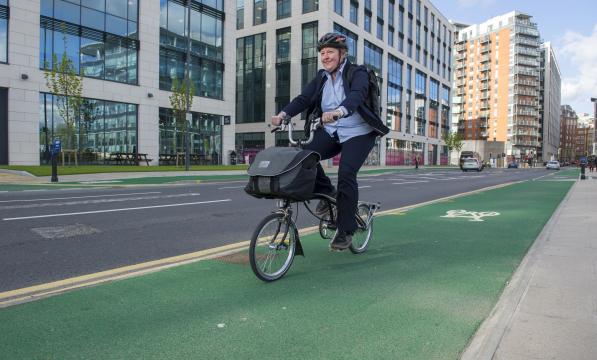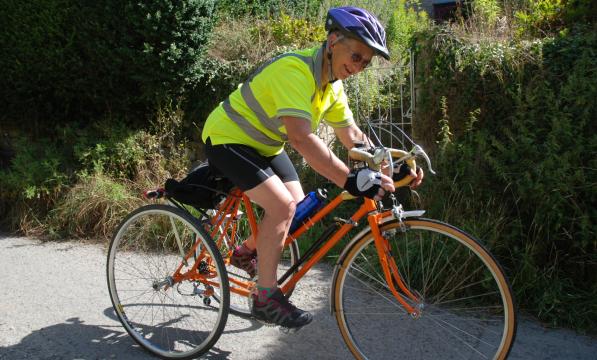How to: Make your workplace winter cycling friendly

There are many reasons to encourage your employees to cycle to work. Commuting by bike can lead to improved wellbeing and fitness. It can also result in better cognitive abilities, as well as reduced absenteeism – on average people who cycle to work regularly take 1.3 fewer sick days per year than those who don’t. All of which means a happier, healthier and more productive workforce.
It’s also better for the environment and helps reduce pollution. It can save people money on public transport and maintaining a car and save employers money on supplying parking spaces.
But cycling through the winter can be a challenge. Wet and cold weather, short days, muck all over the roads. So how can you keep – or even get – your employees cycling to work this winter?
Access to bikes
The first thing to consider is whether your employees have access to affordable, good-quality cycles. Cycling to work can save a lot of money, but for those who don’t already have a bike there is an initial outlay, which can be expensive. There’s also the cost of accessories such as lights – particularly important at this time of year.
One way of helping is to sign up to a Cycle to Work scheme. This allows workers to purchase a cycle, along with accessories, at a discounted price as part of a salary sacrifice arrangement. It costs employers nothing and even saves money on National Insurance payments.
If your employees travel between sites, access to pool cycles that they can borrow would be very useful. What sort of bikes you provide will depend on your business needs. If separate locations are very far apart and require some travel by train or bus, for example, then a pool of folding bikes would be best. If they’re likely to need to transport goods, then cargo bikes or even e-cargo cycles would work.

Safe and secure
Now that employees have access to cycles, they’ll need somewhere to store them. In winter it’s especially important that cycle parking is fully protected from the weather. No one is going to want to leave their precious steed at the mercy of the elements.
Cycle parking should also be secure – ideally lockable with only employees having keys or key codes to access the area. It needs to be well lit, especially in winter as it’s likely to be dark when people are going in and out. Covering the area with CCTV will provide an extra layer of protection.
You’ll need racks for bikes to be locked to. Wall-hanging versions make good use of space, but keep in mind that not everyone will be able to lift their cycles. A mix of wall-hanging racks and ground-mounted ones is best. Consider space for non-standard cycles, such as tricycles, too. Will everyone be able to easily manoeuvre their cycle?
Location matters. Putting bike parking out of sight around the back of the building where no one goes isn’t going to encourage anyone to use it. If possible, have it in full view and where there’s plenty of footfall.
Roads get very mucky at this time of year, leaving cycles filthy. So if you can, providing an area where employees can give their bikes a quick wash would be helpful.
Keep it clean
Talking of washing, access to a hot shower and somewhere to change would surely be top of most cyclist’s must-have lists when cycling to work in winter. Arriving at work cold, wet and covered in spray from the roads is no fun if you can’t clean up.
An area where employees can hang up wet cycling gear and towels will stop these being draped over the backs of chairs or – more worryingly – radiators. Lockers where shower gel and shampoo can be kept will save employees from having to carry them in every morning.
Can I fix it?
Punctures are a lot more common in winter than the summer months. This is thought to be because rain washes debris and grit into the roads, where it congregates at the edges, where cyclists tend to be.
A lot of potential cyclists are put off by the thought of having to fix a puncture or carry out other basic maintenance skills. This is particularly important in winter when the weather is taking its toll on bikes.
Tell employees exactly what you’re doing to encourage them to cycle – and ask them if there’s anything they need
You can help by offering skills sessions showing people how to change an inner tube, fix a puncture and carry out other checks and fixes. You can work with a local bike shop for this, or it might be that you’ve got an amateur mechanic among your employees who would be happy to share their knowledge.
Offer a library of information on basic maintenance. This can take the form of books, leaflets, access to online videos, or a combination. Cycling UK has a hub of free information to get you started.
It would also help to have tools on hand that employees can use. This doesn’t have to be comprehensive: a multitool, tyre levers, a basic cleaning set (brushes, cloth, brake cleaner, degreaser, lube), spare inner tubes and a track pump should cover it.
An area where cyclists can charge lights and e-cycle batteries would provide peace of mind, but a couple of sets of spare lights that employees can borrow if their own stop working would really help, too.
Culture club
The easier you make it for people to cycle to work, the more people will do it. Part of this is building a cycling culture at your workplace. Key to this is communication. There’s no point investing in fantastic cycle parking if no one knows about it.
Tell employees exactly what you’re doing to encourage them to cycle – and ask them if there’s anything they need. Use clear signage to point out where things like showers, lockers, bike parking, and your tools and information libraries are. Let staff know about skills sessions well in advance – and if possible run them during work hours so they don’t have to give up their own time.
A work cycle group can provide support and help for staff starting to cycle. Known as Cycle User Groups (CUGs) or Bicycle User Groups (BUGs), they look after the interests of existing cyclists and encourage other employees to take up cycling. Setting one up is simple and will bring many benefits.

Try helping employees find suitable routes. This can be as simple as providing maps, or you could create a ‘cycle buddies’ scheme in which more experienced riders show new cyclists good routes and accompany them as far as possible.
All of this might sound expensive and time consuming. But it really doesn’t have to be. If some employees currently cycle, then you’ve already got access to much of the skills and knowledge you need – and they’re likely to be flattered to be asked.
Many areas across the UK have local cycle campaign groups which may be willing to share knowledge and advice. These groups will have many years’ experience fighting for things like safe, well-lit cycle lanes and will be very happy if you were to add your voice to this argument.
Similarly, reach out to local bike shops. Again, they will have invaluable advice they can share, and might even be able to offer your staff a discount in return for you recommending their services.
Cycling UK also has a huge amount of knowledge when it comes to encouraging cycle commuting. Our Cycle Friendly Employer scheme is recognised as the international benchmark for active travel culture and infrastructure in the workplace. Once accredited, Cycle Friendly Employers can access bespoke, ongoing support from Cycling UK.




